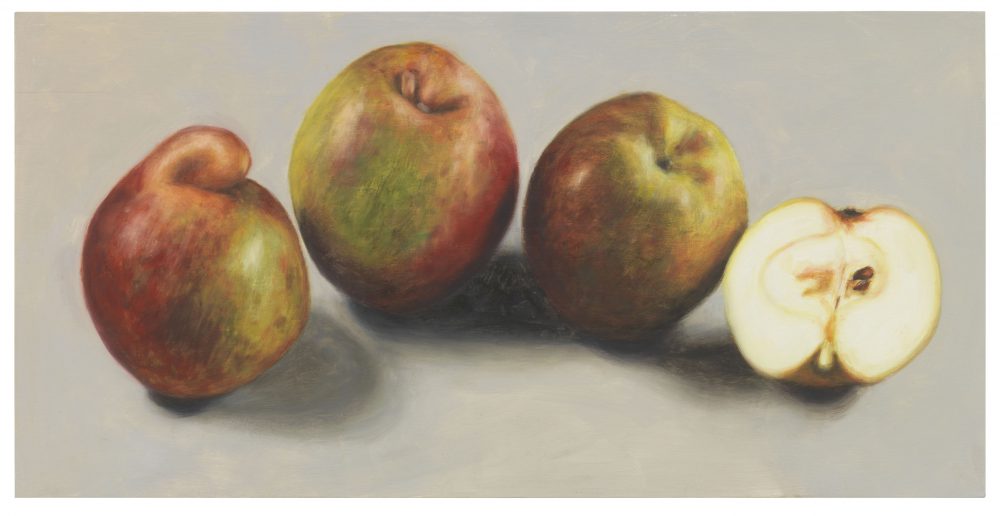Focus: Three questions for Antje Majewski
The theme-based exhibition The Apple. An Introduction. Again and Again looks at the apple as a tradition-steeped fruit from both an artistic and cultural history perspective. For this show, the Kunstmuseum Thun is working closely with the artists Antje Majewski and Paweł Freisler, who have for many years dedicated themselves to the theme of the apple. Their engagement involves both an aesthetic and symbolic examination, for example in Majewski’s apple paintings and Freisler’s carved apples, as well as exchanges with the scientific field and agricultural sector. The issues raised include biodiversity, conservation of different varieties, nutrition, resilience and climate change. Also on view in the exhibition will be works by contemporary Swiss artists on the subject of apples.

1: What made you want to develop a large-scale international exhibition project about apples?
The apple is a fruit we all think we know – the most popular fruit in our latitudes and one that has been part of our culture for centuries. Before our first exhibition together, Paweł Freisler set the condition that it should be about apples only. I then discovered that I didn’t actually know anything about apples. Where do they come from, how are they grown, how many varieties of apples are there actually? Why can apples look so different? And why are we seeing less and less of this variety of colours and shapes in our supermarkets?
The apple is prime example of what a great cultural achievement the development of our different varieties of fruits and vegetables is, but also of how this diversity is threatened by global trade, industrial agriculture, and the demands of consumers who are often no longer aware of this diverse heritage. So I would like to use art as a means to demonstrate what we have gained from thousands of years of cooperation between nature and (agri-)culture, and what we are in danger of losing.
2: The apple plays an important role as a symbol in art. What were the main criteria for selecting contemporary artists for the show?
The exhibition features artists who have, like us, dealt with apple trees in their art or whose work otherwise revolves around the themes of gardens, apples and planting: Jimmie Durham with his planting of an apple tree in the Karlsaue in Kassel for documenta 13; Agnieszka Polska with a film about Paweł Freisler’s imaginary garden; Piotr Życieński with his photographs of Freisler’s apples.

At the Kunstmuseum Thun, Majewski / Freisler’s apple project now enters into a dialogue with the works of Swiss artists Brigham Baker and Didier Rittener. Brigham Baker’s large-format, poetic photographs of apples focus on the very individual, unrepeatable form of the fruit in various states of ripeness and decay. These images correspond with Paweł Freisler’s preserved apples in their artistic contemplation of time and transience and in the love of both artists for the wonderful variations that nature produces. Didier Rittener’s enchanted garden, which combines apple trees from a wide variety of sources to create a dream image of an “indecent garden”, gives us a taste of the timelessness of art and its variations.
All of these artworks are interwoven to form a large installation that addresses the important questions of life: questions about nature and culture, time and transience, beauty and mourning.
3: You have also created a local context for the project by including works from the collection of the Kunstmuseum Thun on the theme of apples. You also made a new video for the exhibition with the organic farmers Sandra and Marc Schlotterbeck in Hohmad near Thun. How important is it to you to involve local exponents, and what will be different in Thun?
The apple is found all over the world and yet it is also very local. You can find apples from China to North America – and they originally came from Kazakhstan. For me, the best way to understand and tell this story is to keep anchoring it in the local context. The local farmers but also urban gardeners, plant breeders, children, retailers, consumers, all of them taken together produce apples – as a fruit and as a cultural asset.
I always find it interesting to look into the local collections of the institutions and find paintings with apples that have not been shown for a long time, by artists who have often been forgotten – and perhaps to discover new beauties there, just as with old local apple varieties.